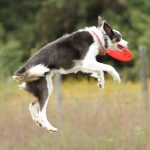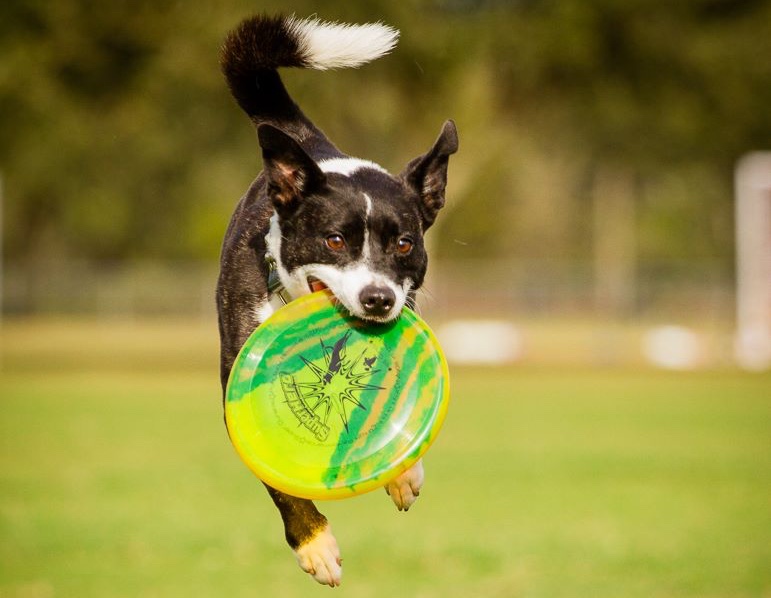
Learning to Run Patterns – Drill #1
One thing that separates the Pros from the soon to be Pros is Throwing With Intent, intending to throw to a spot Spot is a “go to a place”, or “go to a mat” behavior. This means that the dog seeks out and performs a duration behavior on a spot of the handler’s choosing. A... More at a particular distance, height and time in order to elicit a jump from your dog. Sounds easy, right?
Spot is a “go to a place”, or “go to a mat” behavior. This means that the dog seeks out and performs a duration behavior on a spot of the handler’s choosing. A... More at a particular distance, height and time in order to elicit a jump from your dog. Sounds easy, right?

Well it is easy for some of us. Former football players are well aware of hitting a moving target via the Quarterback/Receiver relationship in their games. Soccer players know where to put it when a teammate “shows for the ball”. Hockey players fully understand how to pass the puck for a one-timer. Basketball players make unbelievable passes on the Fast Break. Baseball players are expert at throwing and often have football experience.
There are some other athletic histories that can serve as foundational understanding of hitting a moving target in stride (Perhaps you’ll leave a comment below to draw attention to them.), but many people just do not have that particular athletic history to draw from and are not familiar with that concept.
You can see this in the game of disc frequently:
Dog is running back to the handler with a disc in their mouth… handler calls the drop, and makes an impossible to catch throw 20 yards behind the dog. The dog stops, looks at the handler as the disc flies off in some uncatchable direction. “Dude! How am I supposed to catch that!”
This phenomena was the genesis of Throwing With Intent, which was fleshed out and developed through the following series of drills that we use in our Discdog Seminars.
Setting the Flank

The first thing we need to do is to get our dog out, away from us, in some direction other than straight out away from us.
Send your dog around and throw a 7-10 yard throw out to the right or left. You may throw 90° degrees or 270°. That’s it.
Directional Feeding
Once we can successfully set the flank we’re ready to try Directional FeedingDirectional Feeding is the underlying essence of disc dog freestyle. As a concept, it consists of reading the dog’s line and delivering a well placed disc that elicits a leap where she is... More.
All we have to do is grab a handful of discs and set the flank. We call the drop shortly after the catch. Then we wait.
As soon as the drop happens, we mark and reinforce with a thrown disc on the line that the dog has chosen. Ideally, we are looking to make a throw that hits our dog in stride and elicits a leap. Now The Now Phase is an integral part of the Play Cycle in the Play+ training philosophy. It embodies the current, immediate interaction between the handler and the dog, anchoring them in the present... More you may or may not be able to do that right off the bat, and that’s OK, it’s one of the main goals of this exercise to teach the handler this skill.
The Now Phase is an integral part of the Play Cycle in the Play+ training philosophy. It embodies the current, immediate interaction between the handler and the dog, anchoring them in the present... More you may or may not be able to do that right off the bat, and that’s OK, it’s one of the main goals of this exercise to teach the handler this skill.
While doing this drill we should also be paying attention to how are dogs are moving. What patterns are they running in? X or O? Do they turn right after a catch or left? Do they tend to drift in one direction or the other – to the handler or away from the handler? Another goal of this exercise is to learn how our dogs move on the Frisbee field.
Working Off the Drop
This drill also is great for teaching our dogs to drop a disc on the fly, something that can be maddening for those with a strong Toss and Fetch Foundation. Many disc dogs have been conditioned to retrieve discs and have problems dropping away from their handler. These dogs understand the game as a game of Fetch, “You throw it, I go get it and bring it back to you.” That’s it.
These dogs will have problems with Directional Feeding. They won’t drop when asked and will wind up dropping right at the handler’s feet, making the task of finding the dog’s chosen line difficult, if not impossible.
If your dog has this problem, just ask for the drop later in the retrieve process when it’s likely to happen. When the drop happens, mark the drop and throw another disc behind you, or off to the side, that the dog can catch. It’s important for the dog to learn that the Drop on Cue makes the next disc happen. It’s also important that they play with multiple targets, as that frees up the idea of dropping a disc to get another one.
Once the dog believes that dropping the disc makes the next one happen, they’ll be spitting the disc out when the drop is cued.
Troubleshooting a drop on the fly with Directional Feeding is a bit beyond the scope of this piece. I’ll do another piece (or a video) on getting a drop on the fly in the future, but will be happy to take some questions in comments below. (see the CookieA Cookie is traditionally thought of as a food treat given as positive reinforcement. In that definition, a cookie is a discrete piece of food reinforcement. In many dog training discussions, the idea... More Process – for an important troubleshooting concept…)
Wrapping Things Up
Setting the Flank Setting the Flank means to throw out to your right or left. It’s really simple, just face any direction, send the dog Around, and then turn and throw the disc out to the... More and Directional Feeding are foundational aspects of playing Disc with your dog. They are required for capitalizing on Discdog Flatwork
Setting the Flank means to throw out to your right or left. It’s really simple, just face any direction, send the dog Around, and then turn and throw the disc out to the... More and Directional Feeding are foundational aspects of playing Disc with your dog. They are required for capitalizing on Discdog Flatwork Flatwork is the stuff that happens between the catches. How the team moves and transitions, often without the disc, is flatwork. Flatwork concepts in disc dog are taken from the agility and herding... More to create flow and for creating depth in the game of Freestyle. Building an Around the World
Flatwork is the stuff that happens between the catches. How the team moves and transitions, often without the disc, is flatwork. Flatwork concepts in disc dog are taken from the agility and herding... More to create flow and for creating depth in the game of Freestyle. Building an Around the World An Around the World is a disc dog flatwork pattern consisting of 4 catches in a circular pattern around the handler. This pattern is typically larger than 5 yards and often features creative... More, Zig Zag
An Around the World is a disc dog flatwork pattern consisting of 4 catches in a circular pattern around the handler. This pattern is typically larger than 5 yards and often features creative... More, Zig Zag A Zig Zag is a series of catches in smooth succession that forces the dog to move back and forth across the field. Usually performed at a distance of 8-20 yards, the Zig... More or any kind of sequence that happens away from the handler is dependent upon the dog and handler mastering the skills of this drill.
A Zig Zag is a series of catches in smooth succession that forces the dog to move back and forth across the field. Usually performed at a distance of 8-20 yards, the Zig... More or any kind of sequence that happens away from the handler is dependent upon the dog and handler mastering the skills of this drill.
The next step in this series of drills would be Directional Leading, which is where the handler starts to take some ownership of the line the dog strikes after the catch and starts to actively move their dog around the field.










if its a basketball that’s going to be easy for me to throw it with intent . but give me a disc lol i think i have to learn to throw first before doing that so im back to sqr 1 lol
Wednesday is getting closer, Chardy! 😉
Lacrosse! As a former collegiate player and high school and middle school coach, directional feeding is critical! After we work on more stationary work building capacity for catching and throwing skills, the entire game is in movement. All of our drills, plays and attack patterns are based on directional feeding. My position (low attack) had the singular job of setting up behind the goalie and working on feeding to incoming players to score. Hah, my stats had a high number of assists…. but without the correct assist (placement, accurate speed in assessing where the recipient is going to be when) the goal simply couldn’t be made. The best, most flashy plays are those when the feeder and scorer were in sync, seemingly communicating with eyes and body language alone. Glad I finally have something to draw on for this sport, makes me feel less like a total novice 🙂
This may be a stupid question, but when you say 90 degrees, you don’t mean directly in front of us, right? Because that’s what I think when I hear 90 degrees. Do you mean straight out to our left?
Also, do we send the dog around the same direction for either the 90 or the 270, or is the 90 a clockwise and the 270 a counter-clockwise? From the diagram it looks like the dog is running clockwise for both.
Thanks!
Sorry, I just realized both of these questions are answered in the “Flanking and Feeding” video! I’m good now.
Not a very good explanation by me here, Sarah… I think you got it now.